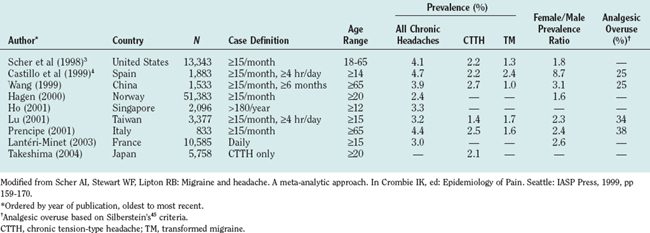CHAPTER 58 CHRONIC DAILY HEADACHE
Chronic daily headache (CDH) of long duration is a clinical syndrome defined by headaches that occur for 4 hours a day or more on 15 days or more a month for more than 3 months.1,2 CDH is one of the most common and disabling headache presentations in headache specialty care centers; it afflicts 4% to 5% of the general population.3,4 Many patients with CDH are severely impaired.5 CDH sufferers also have higher disability than those with episodic migraine.6
As a syndrome, CDH was not included in the first or the second edition of the International Classification of Headache Disorders (ICHD).7,8 As a consequence, several separate proposals for its classification have emerged. Silberstein’s and Lipton’s criteria have been most widely used2 (unpublished data).
The S-L criteria divide primary CDH into transformed migraine, chronic tension-type headache (CTTH), new daily persistent headache (NDPH), and hemicrania continua and subclassify each of these into subtypes “with medication overuse” or “without medication overuse” (Table 58-1). Of these, only CTTH was included in the ICHD-I7 classification, whereas the ICHD-II8 has detailed diagnostic criteria for all four types of primary CDH of long duration. The term chronic migraine was introduced in place of transformed migraine and has a very different definition, as discussed later in this chapter. Although the ICHD-II is a vast improvement, recent studies show that it remains cumbersome for the classification of CDH in adults.9
TABLE 58-1 The Classification of the Chronic Daily Headaches* According to Silberstein’s and Lipton’s2 Criteria
* Daily or near-daily headache lasting ≥4 hours for ≥15 days/month.
EPIDEMIOLOGY OF THE CHRONIC DAILY HEADACHE
The epidemiology of CDH has been described in a number of population samples based in Europe, Asia, and the United States (Table 58-2).3,4,10,11 The prevalence of CDH is remarkably consistent among studies, ranging from 2.4% (Norway) to 4.7% (Spain). In the United States, the prevalence is 4.1%. From 35% to 50% of CDH sufferers in the population have transformed migraine.
TABLE 58-2 Prevalence of Very Frequent Headaches in Adult Populations According to Silberstein’s and Lipton’s2 Criteria

The incidence of CDH was investigated in a prospective study in the United States. Among subjects with episodic headaches at baseline, 3% developed CDH within 1 year.12 The incidence among migraine sufferers in subspecialty care is 13%.
Clinic-based studies show that CDH affects up to 80% of the patients presenting in a headache clinic.13–16 In this setting, transformed migraine is by far the most common type of CDH. In a study by Mathew and associates,14 77% of the patients with CDH had transformed migraine. In our clinic, transformed migraine represented 87.4% of the cases of CDH seen in a headache specialty center.13
CLINICAL CHARACTERIZATION
Transformed Migraine/Chronic Migraine
Patients with transformed migraine have a history of migraine. Sufferers usually report a process of transformation over months or years, and as headache frequency increases, associated symptoms become less severe and frequent.13–16 The process of transformation frequently ends in a pattern of daily or nearly daily headache that resembles CTTH, with some attacks of full migraine superimposed.2 In the clinical setting, migraine transformation is most often related to acute medication overuse, but transformation may occur without overuse.17 In the general population, most cases of transformed migraine are not related to medication overuse.12 Multiple risk factors may be involved in these cases (see section risk factors for the development of CDH).
The International Headache Society proposed criteria for the diagnosis of transformed migraine: (1) Headache frequency is 15 days or more per month for 3 months or more, with an average headache duration of more than 4 hours/day (if untreated); (2) the headache fulfills criteria for migraine without aura, on 8 or more of the headache days; and (3) the headache does not meet criteria for CTTH, hypnic headache, hemicrania continua, or NDPH (Table 58-3).
TABLE 58-3 Diagnostic Criteria for Primary Chronic Daily Headaches According to the International Classification of Headache Disorders (2004) Criteria and Silberstein’s and Lipton’s2 Criteria
ICHD-II, International Classification of Headache Disorders, 2nd ed.; IHS, International Headache Society; S-L, Silberstein and Lipton.
The terms transformed migraine and chronic migraine have been used synonymously in the past, but this is no longer appropriate: Chronic migraine has a specific definition in the ICHD-II, which does not recognize transformed migraine as a separate entity.8 One main difference exists between the S-L–AHS (transformed migraine) and ICHD-II (chronic migraine) systems: The ICHD-II criteria for chronic migraine require that headaches meeting criteria for migraine without aura occur on at least 15 days a month. To classify transformed migraine, the S-L–AHS criteria require at least 15 days of headache (not necessarily migraine), in which at least 50% of the days fulfill criteria for migraine or probable migraine.
Chronic Tension-Type Headache
CTTH (see Table 48-3) represents one half of the CDH cases found in population studies but just a small fraction of those found in specialty clinics. It is the only CDH that was addressed by the ICHD-I as a single diagnosis.7 The criteria remained little changed in the ICHD-II.8 Despite the International Headache Society criteria distinguishing between episodic headache and CTTH, this headache remains surprisingly poorly studied. This can be explained partially by the confusion between CTTH and transformed migraine with a low frequency of superimposed migraine attacks.
The prevalence of CTTH is markedly lower than that of episodic tension-type headache (ETTH), the most prevalent primary headache disorder. Its 1-year prevalence estimates range from 1.7% to 2.2%.18,19 The female preponderance of CTTH is greater than that of ETTH. In the United States, the prevalence of CTTH was reported to be 2.8 among women and 1.4 among men, with an overall gender prevalence ratio of 2.0.20 The prevalence of CTTH increases with age.
If the CDH develops abruptly (de novo), patients are said to have NDPH.
Stay updated, free articles. Join our Telegram channel

Full access? Get Clinical Tree








